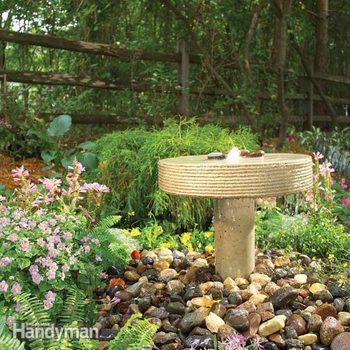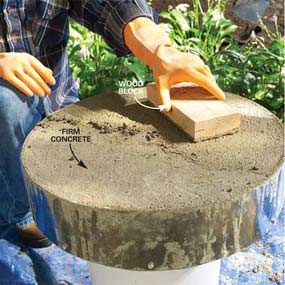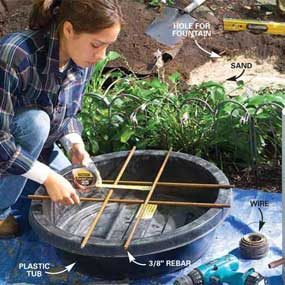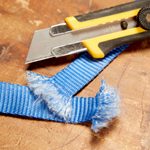How to Build a Garden Fountain
Updated: Jan. 24, 2022Cast this fountain in a weekend with a few bags of concrete and some hardware odds and ends.

- Time
- Complexity
- Cost
- Multiple Days
- Beginner
- $101–250
Small Garden Fountain Step 1: Overview
Enjoy the sound of water trickling over river stones. Watch the birds and butterflies that come to bathe and drink.
We’ll show you how to build this simple fountain using bagged concrete mix and common construction materials. You can build the sheet metal forms and pour the concrete in less than a day. The next day, you can finish up by removing the forms, burying the tub, and assembling the concrete fountain and the pump.
With the increased popularity of water gardens, most home centers now stock fountain pumps and plastic liner tubs. We purchased a pump with a flow rate of 130 gallons per hour and a maximum pumping height of 4.5 ft. Make sure the pump you buy has similar specifications. You can substitute any large plastic container for the 7-in. deep tub we used as long as it’s at least 26 in. wide. Fifteen-inch deep plastic whiskey barrel liners work well. The increased depth calls for a little extra digging, but you won’t have to refill the fountain as often. Increase the height of the concrete column to compensate for the extra depth.
In addition to basic tools, you’ll need a plastic tub or wheelbarrow and a hoe for mixing concrete, and a steel trowel to finish the top of the wheel.
Figure A: Small Garden Fountain Details
Here is a cross-section of this garden fountain.
Small Garden Fountain Step 2: Solid forms are the first step to a successful concrete pour
When you build the forms for the concrete, take care to cut the plywood circle accurately and wrap the metal tightly around it (Photo 1). The double-faced tape holds the band of sheet metal to the plywood disc while you screw it in place. We lined the metal with foam sill sealer to create the ridges you see on the outside of the wheel. You can customize the wheel to your liking by substituting seashells, rope or other decorative items for the sill sealer. Attach them to the metal with hot-melt glue or double-faced tape.
We made the form for the column by snipping one locking edge and the end from an 8-in. round duct and rolling it into a 5-in. diameter cylinder (Photo 4). Allow the extra sheet metal to overlap. Complete the form by assembling and installing the copper pipe and taping the whole thing together with duct tape (Photo 5).
Don’t forget to coat the inside of the forms, including the short copper pipe, with oil to prevent the concrete from sticking. We used a heavy layer of WD-40. The band of rope caulk in the bottom of the form creates a recess in the concrete that directs the water to drip from the edges, rather than run under the wheel.
Small Garden Fountain Step 3: Strong concrete mix has just the right amount of water
Too little water and the concrete mix will be stiff and unworkable. Too much water results in weak concrete prone to cracking and breaking. Start by dumping 1-1/2 bags of concrete mix into a wheelbarrow or plastic mixing tub. Then measure out the amount of water recommended on the bag and add it slowly while mixing the concrete with a hoe. Check for the proper consistency by making a trench with the hoe. The concrete should stand up on both sides of the trench. If it sags and fills the trench, it’s too wet. Add more dry powder to make a stiffer mix. It should be about the consistency of potato salad.
It takes a little more effort to get this thick concrete mix to settle into the forms. The trick is to tap on the outside of the forms after they’re filled with concrete (Photo 7). Tapping eliminates air pockets that would otherwise show up as holes in the concrete surface.
After filling and tapping the forms, you have to let the concrete harden for a while before smoothing the top surface (Photos 8 and 9). The length of time will vary between 45 minutes and three or four hours depending on the weather and other factors. The concrete is ready when the surface water is gone and you can barely indent the surface with your thumb.
Smoothing the top surface requires two steps: floating and troweling. Float the surface by rubbing the concrete in a circular motion with a block of wood (Photo 8) until a thin layer of soupy, rock-free cement covers the surface. Next, flatten and smooth the surface with a steel trowel (Photo 9).
CAUTION!
Wear long rubber gloves and safety glasses when you’re working with concrete. Wet concrete can seriously burn bare skin.
Small Garden Fountain Step 4: Assemble the fountain
Remove the forms after the concrete has set up for at least 12 hours. If you don’t plan to assemble the fountain immediately, cover the column and wheel with plastic and store them in a shady spot until you’re ready. Otherwise, keep the fountain running for at least a week to keep the concrete wet while it cures.
Photos 11 – 14 show how to assemble the fountain and connect the pump. Use a hacksaw to cut the rebar to length. Be very careful when you’re working with the hardware cloth—the cut edges have razor-sharp points. Wear leather gloves and bend all cut edges down before you install the cover over the tub. Don’t cover the hardware cloth with stones until you’ve filled the tub with water and tested the pump. To avoid the risk of electrical shock, make sure the circuit you plug the pump into is GFCI protected.
Fountains Require a Little Maintenance
Keep the tub full of water. If it dries up while the pump is running, it will ruin the pump. Check the intake grate or screen on the pump occasionally and remove leaves and debris. If you live in a cold climate, drain the fountain in the fall. Then clean out the liner and store the pump inside for the winter.
Required Tools for this Small Garden Fountain Project
Have the necessary tools for this DIY project lined up before you start—you’ll save time and frustration.
- Cordless drill
- Jigsaw
- Level
- Spade
- Steel
- Wheelbarrow
Required Materials for this Small Garden Fountain Project
Avoid last-minute shopping trips by having all your materials ready ahead of time. Here’s a list.
- 1-1/2 to 2-1/2 in. dia. river rock to cover hardware cloth
- 1/2 in. copper elbow
- 1/2- to 3/8-in. copper reducer
- 16 ft. of 3/8-in. steel rebar
- 2-ft. length of 1/2-in. copper pipe
- 2-ft. length of 8-in. round metal duct
- 3 ft. of 5/8-in. outside diameter (O.D.) plastic tubing
- 3/4-in. plywood
- 36 x 36-in. square of 1/4-in. galvanized hardware cloth
- 4 ft. of 14- or 16-gauge wire
- 5-ft. length of 4-in. wide sheet metal flashing
- 5-ft. length of ribbed foam sill sealer (cut from roll)
- 5-in. round duct cap
- 5-in. round duct coupling
- Duct tape
- Plastic tub
- Pump
- Roll of double-faced carpet tape
- Rope caulk
- Twenty 1/2-in. sheet metal screws
- Two 60-lb. or 80-lb. bags of concrete mix
- Two hose clamps for above tubing
- Two-part epoxy (five-minute type)



















